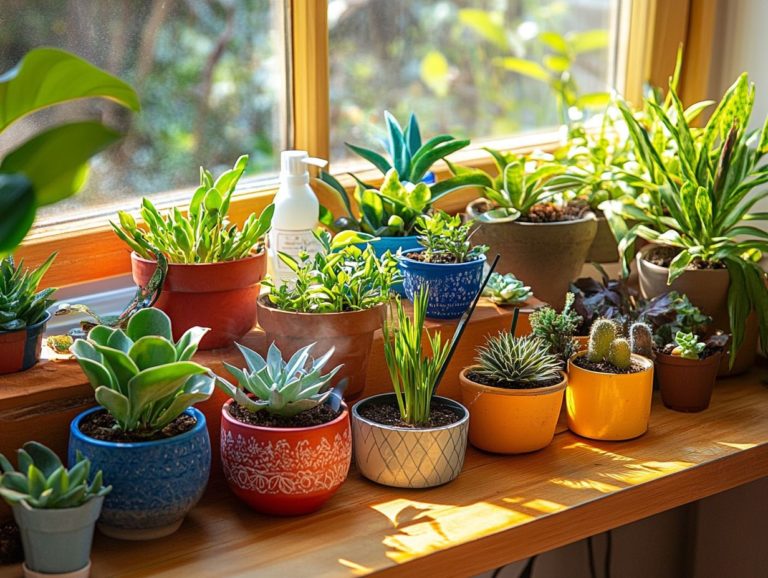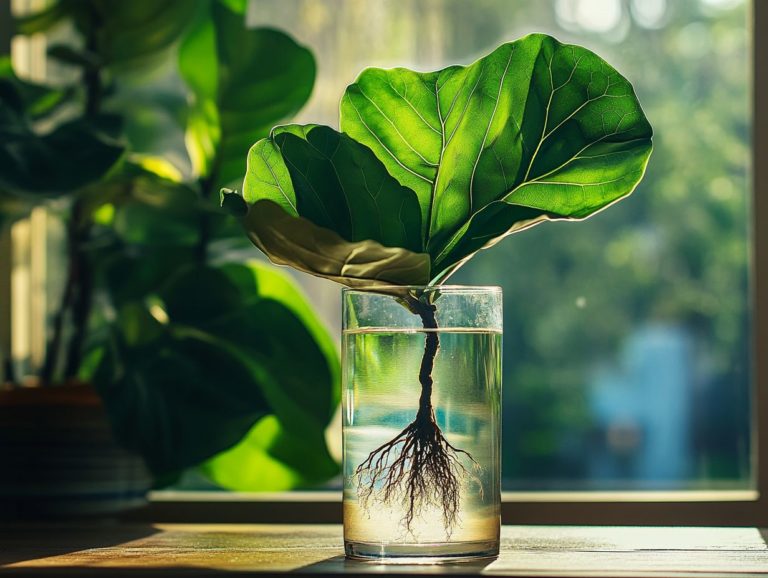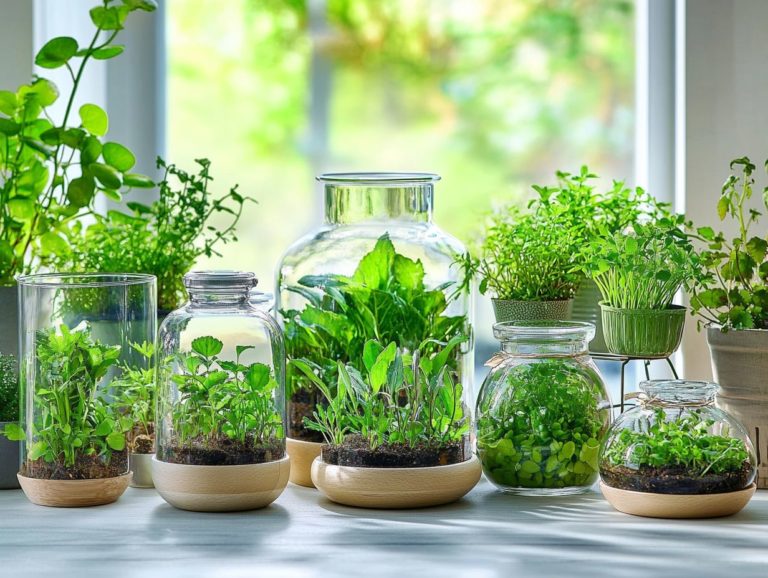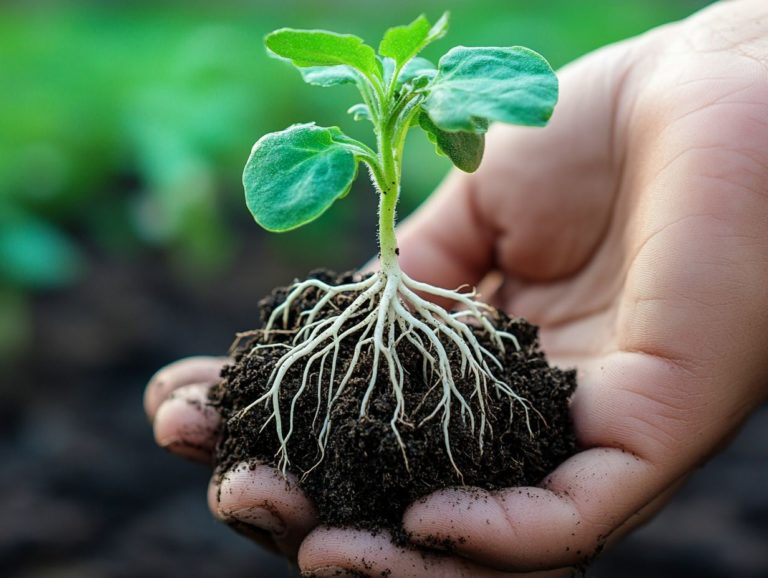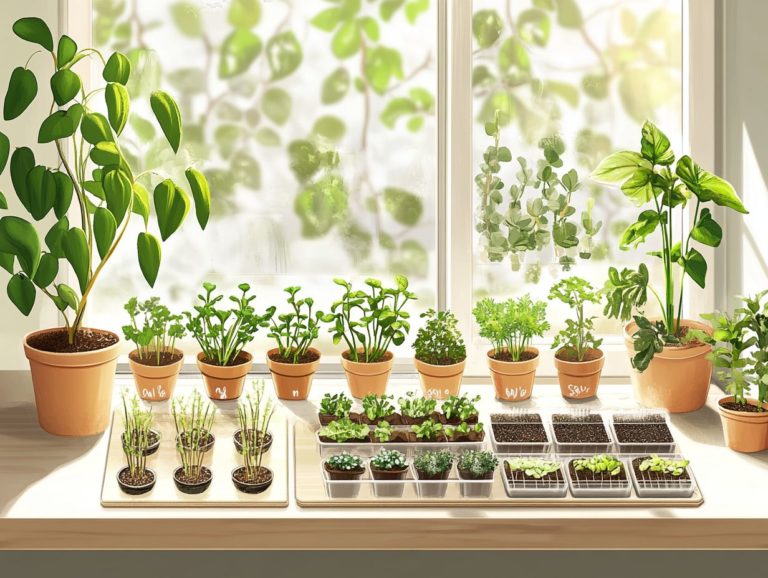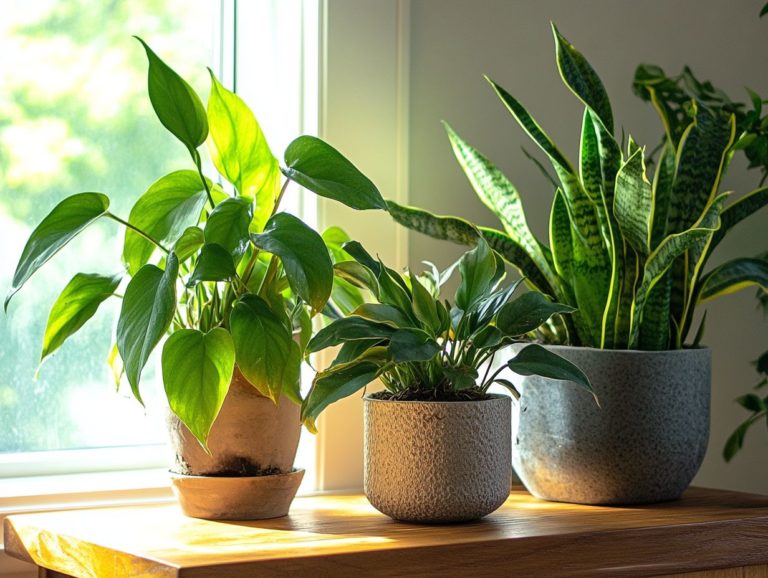How to Propagate Rubber Plants
Propagation offers an exceptional opportunity to expand your indoor jungle, particularly with beloved houseplants like rubber plants.
This guide will walk you through an array of propagation methods, including leaf cuttings, a method involving layering a part of the plant to encourage roots to grow, and stem cuttings. You will discover the essential preparations needed, from gathering the right materials to timing your efforts for maximum success, along with propagation tips.
You will find a detailed step-by-step guide for propagating rubber plants, along with invaluable rubber plant care tips for nurturing your new green companions.
Get excited to transform your indoor space into a lush paradise!
Contents
- Key Takeaways:
- Methods of Propagation
- Air Layering
- Stem Cutting
- Preparing for Propagation
- Step-by-Step Guide to Propagating Rubber Plants
- Caring for Newly Propagated Rubber Plants
- Frequently Asked Questions
- What is the best way to propagate rubber plants?
- When is the best time to propagate rubber plants?
- How long does it take for rubber plant cuttings to root?
- Do I need to use rooting hormone when propagating rubber plants?
- Can I propagate rubber plants from leaves?
- How often should I water newly propagated rubber plants?
Key Takeaways:

- Propagation creates new plants from existing ones through methods such as plant cutting and stem cutting, especially of the rubber plant.
- Before propagating, gather necessary materials, like gardening tools and a suitable soil mix, and choose the right time to ensure successful results.
- Follow detailed cutting instructions for each method to effectively propagate rubber plants and care for newly propagated plants with pruning and maintenance tips.
What is Propagation?
Propagation is the art of creating new plants from existing ones; a favored technique among gardening enthusiasts looking to multiply their beloved indoor plants, like the ever-popular rubber plant (Ficus elastica). This not only expands your plant collection but also opens delightful opportunities to share healthy cuttings with fellow plant lovers.
Engaging in propagation can significantly enhance the overall health of both the parent plant and its new offspring. For example, with methods like cutting propagation, you tap into the remarkable ability of many plants to regenerate roots from their stems. This process rejuvenates the original plant while ensuring that your new rubber plant retains all its stunning features, from its glossy leaves to its vigorous growth. To learn more about this process, check out our guide on how to propagate your favorite houseplants.
With a variety of propagation techniques at your disposal, including air layering and division, you have the flexibility to choose the method that best suits your needs. Cultivating robust plants transforms your indoor environment into a lush sanctuary brimming with vibrant foliage.
Methods of Propagation
You have a wealth of effective propagation methods to cultivate rubber plants, each presenting unique advantages tailored to various situations in your indoor environment.
Selecting the right approach ensures the successful expansion of your indoor plant collection, enhancing both its beauty and diversity while implementing pest control measures.
Leaf Cutting
Leaf cutting is an excellent propagation method for your rubber plant, making it easy to create new plants from healthy, vibrant leaves equipped with sufficient leaf nodes for successful rooting.
To kick off the process, you’ll want to select the right leaves firm and free from any damage or disease. Once you’ve chosen your leaves, trim them to about six inches long, ensuring each cutting has at least one or two leaf nodes.
Preparing the cuttings properly involves letting the cut ends callous over for a few hours. For optimal results, consider applying a rooting hormone, which helps plants grow new roots quickly, to speed up root development. Maintaining humidity levels is crucial, so seal the cuttings in a plastic bag or use a propagation dome to prevent them from drying out.
Finally, place the cuttings in a warm, bright spot, but out of direct sunlight, to further enhance their chances of successful rooting.
Let s get started on your journey to grow beautiful rubber plants today!
Air Layering
Air layering is an effective propagation technique that allows you to partially cut into the stem of a rubber tree. This encourages robust root growth while remaining attached to the parent plant. This method helps you grow strong, healthy new plants quickly.
This approach is especially beneficial if you want to cultivate thriving rubber plants without the uncertainties tied to traditional seed germination or compost drying.
To execute air layering effectively, you’ll need the following essentials:
- A sharp knife
- Moss or rooting medium
- Plastic wrap
- String or tape to secure the wrap
Start by selecting a healthy stem of the rubber tree and making a shallow cut. Surround the cut with moist moss to create an optimal environment for root formation. Then, wrap this area in plastic to protect it and retain humidity. For those interested in expanding their plant collection, learning how to propagate ZZ plants can be a great addition to your gardening skills.
Once roots have developed typically within several weeks you can separate the new plant and transfer it to a suitable potting mix. Remember to keep the area adequately moist throughout this period to maintain the parent plant’s health.
Try air layering for a fast, reliable way to grow new plants and enjoy your gardening sooner!
Stem Cutting
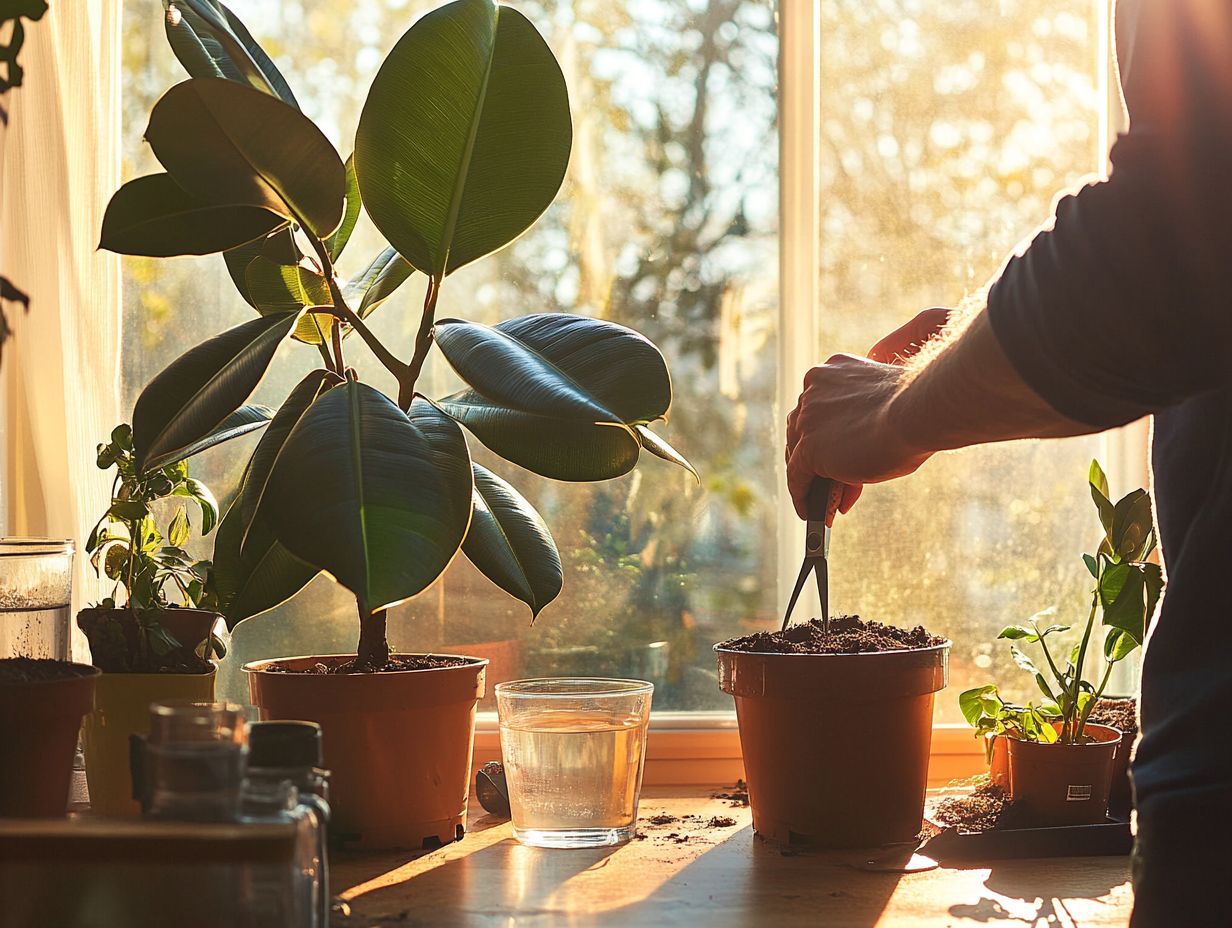
Stem cutting is an elegant propagation method that allows you to take a healthy section from your rubber plant and encourage it to root in a suitable medium. Often, this medium is enhanced with rooting hormone, a substance that helps roots grow, for optimal results.
This technique is a fantastic way to expand your indoor garden without breaking the bank. It offers a rewarding experience for both beginners and seasoned plant lovers alike. The best time to take a cutting is during the spring or early summer when your plant is in its active growing phase, maximizing your chances of successful root development.
To begin, prepare a well-draining soil mix by combining potting soil with perlite or sand to promote aeration. After making your cut, gently place the stem in the prepared medium, ensuring it stays moist but not soggy.
It’s crucial to maintain a warm environment and provide indirect light to encourage rooting while avoiding common pitfalls like overwatering or exposing the cutting to direct sunlight.
Preparing for Propagation
Proper preparation is essential for achieving successful propagation. This involves gathering all necessary materials, selecting the right plant, and understanding the growing conditions.
By addressing these elements, such as cleaning leaves and maintaining humidity levels, you create a favorable environment where new rubber plants can truly thrive.
Gather Necessary Materials
Gathering the necessary materials for propagating rubber plants is crucial for ensuring a smooth and successful process. You’ll want to have quality gardening tools, suitable compost, and perlite on hand to enhance drainage.
These elements support your plants in developing roots and adapting to their new environment. Choosing the right gardening shears allows you to make clean cuts on the stems, which reduces the risk of disease.
When selecting compost, opt for a well-balanced mixture that provides essential nutrients to encourage growth in those critical early stages. Perlite improves aeration and helps prevent root rot, keeping moisture levels just right.
To ensure you’re getting the best materials, consider visiting a trusted garden center. The experienced staff there can help you find organic options that promote robust growth and establish a thriving foundation for your propagation efforts.
Get started with air layering today and watch your garden flourish!
Choosing the Right Time and Plant
Choosing the right time and a healthy rubber plant is crucial for successful propagation. This can greatly influence your success, particularly in maintaining the right amount of moisture in the air and creating suitable indoor conditions for your indoor plants.
Several key factors come into play as you determine the ideal timing for this process. These include seasonal conditions and specific indicators of your plant’s health. Spring is often considered the prime time for propagation, as your rubber plant naturally enters a growth phase during this period. If you’re interested in learning how to propagate spider plants, examine your plant for signs of vitality. Look for healthy, vibrant leaves and well-established roots, as these indicate that it’s ready for propagation.
Pay close attention to root health, since strong roots are vital for successful growth after propagation. By carefully assessing these factors, you can significantly increase the likelihood of your cuttings taking root and thriving.
Step-by-Step Guide to Propagating Rubber Plants
A comprehensive, step-by-step guide to propagating rubber plants equips you with all the essential information needed to successfully cultivate new plants. From the initial selection to the meticulous care and maintenance required after propagation, this guide ensures you re well-prepared for each stage of the journey.
Detailed Instructions for Each Method
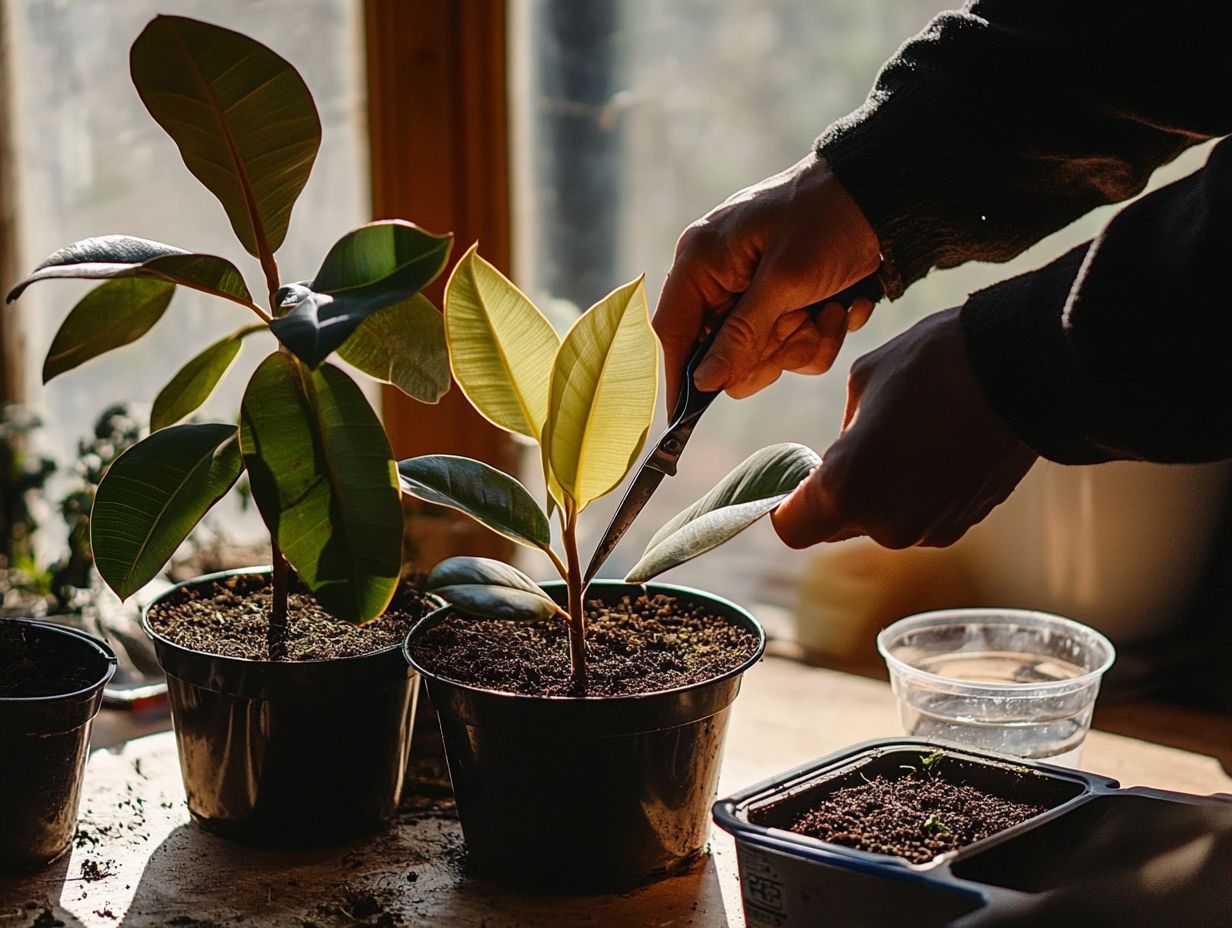
Detailed instructions for each propagation method will equip you with practical insights, guiding you through precise steps to foster the development of healthy roots and vibrant rubber plants while ensuring proper light levels.
Understanding the specific requirements for each method is paramount. For instance, when utilizing stem cuttings, select a robust section of the stem with a few leaves still attached and make a clean cut just below a leaf node.
Prepare a well-draining soil mix combining potting soil with perlite or sand to encourage healthy root growth. Keep your rubber plant thriving by sticking to a consistent watering schedule; allow the top inch of soil to dry out between waterings to prevent root rot.
Regularly check your plant’s health and adjust light and humidity levels to enhance your propagation success. This will result in thriving plants that are the envy of any gardener.
Caring for Newly Propagated Rubber Plants
Caring for your newly propagated rubber plants is vital for their survival and growth. This involves key steps such as transplanting them into appropriate pots and implementing ongoing maintenance practices that foster optimal plant health.
By paying attention to these details, you can ensure your rubber plants thrive beautifully.
Transplanting and Maintenance Tips
Transplanting your newly propagated rubber plants requires a thoughtful approach to pot size, compost type, and optimal light levels to encourage healthy growth and vibrant leaves.
Select a pot that is about 2-4 inches larger in diameter than the current one; this provides ample room for root expansion while preventing pesky waterlogging. For compost, a well-draining mix is crucial consider a blend of peat, perlite, and organic matter; it works wonders.
After completing the transplanting process, gradually adjust the light levels to prevent shock bright, indirect light is your goal. Once your plants are settled, maintaining their leaves is essential; a gentle wipe with a damp cloth will remove dust and enhance photosynthesis.
Establish a consistent watering schedule, typically when the top inch of soil feels dry, to keep your plant thriving. Regularly check for any signs of pests or disease to maintain overall plant health. Give your rubber plant the care it needs now for a flourishing display in your home!
Frequently Asked Questions
What is the best way to propagate rubber plants?
The best way to propagate rubber plants is through stem cuttings. Simply cut a healthy stem from the parent plant, ensuring it has at least 2-3 leaves, and place it in a jar of water or directly into moist soil.
When is the best time to propagate rubber plants?
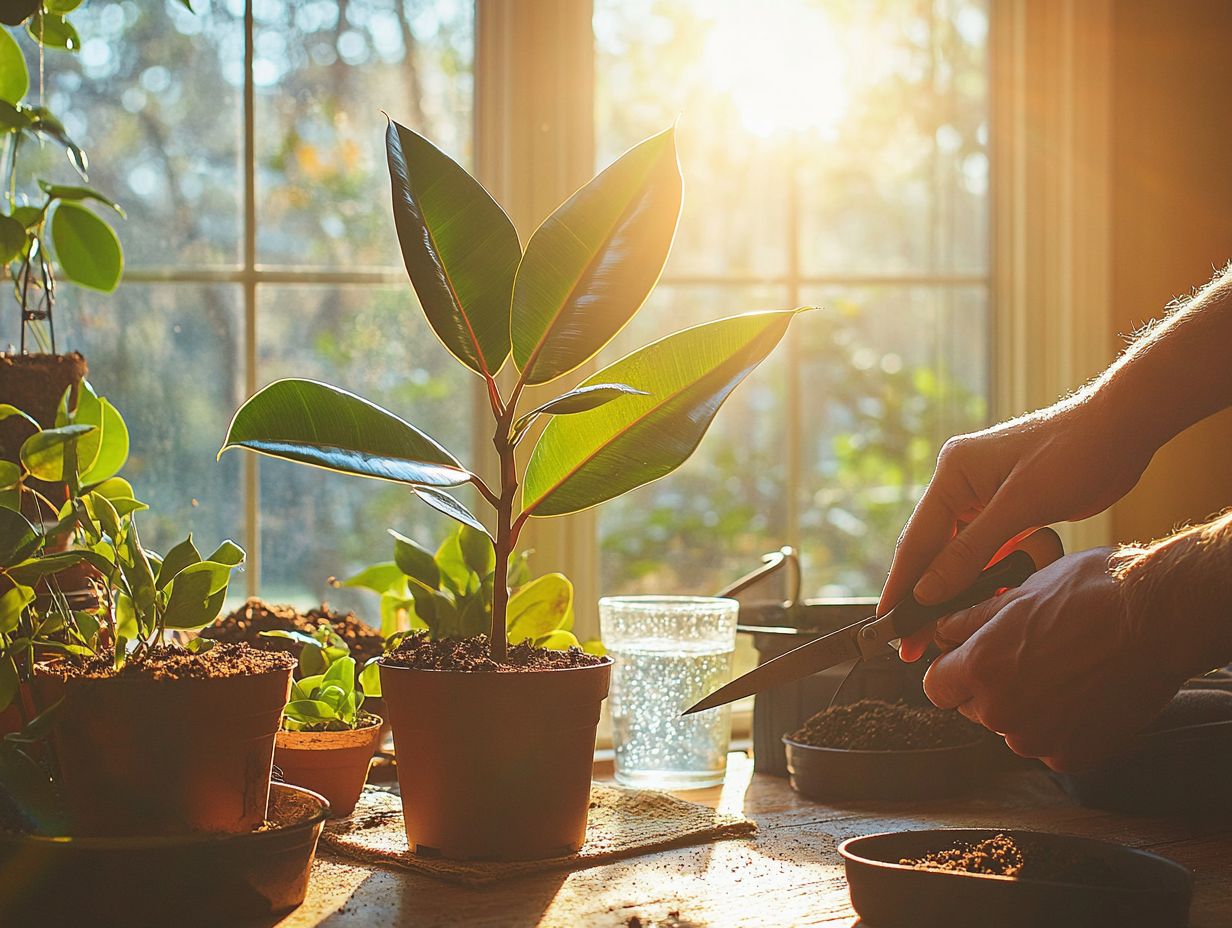
The best time to propagate rubber plants is in spring or summer. This is when the plant grows actively and can produce new roots effectively.
How long does it take for rubber plant cuttings to root?
Rubber plant cuttings typically root in 2-4 weeks. However, this timeframe can change based on temperature and humidity levels.
Do I need to use rooting hormone when propagating rubber plants?
You do not need rooting hormone to propagate rubber plants. They are easy to propagate and will root without extra hormones.
Can I propagate rubber plants from leaves?
Rubber plants cannot be propagated from leaves. Only stem cuttings can grow roots and develop into new plants.
How often should I water newly propagated rubber plants?
After the cuttings develop roots and are planted, water them thoroughly every 7-10 days. Keep the soil slightly moist to avoid root rot.

